Have you ever purchased a car? Or a home? Personally, I rent and over-utilize Uber, but I can imagine that the typical consumer of these valuable items does not simply hop on Google, type in “new car,” and hit “buy now.”
Along with real estate and automotive, there are a plethora of other industries known for their longer sales cycles, such as most industries within the B2B space, software, consulting services, insurance, finance, and the list goes on. Basically, anything that costs a heavy penny and/or has a contract tied to it typically falls into the longer sales cycle category.
Marketers are continuously trying to create engaging content, generate buzz, and nurture leads, in an effort to shorten the sales cycle and push more people through it, but with the longer decision-making process the challenges are much higher. Yes, products and services with longer sales cycles typically cost more and lead to more revenue, but marketers need to make sure that they’re not spending more of their budget to gain the sale than the sale itself is actually worth (cough, cough, ROI is critical).
Hold up, what is a sales cycle?
“A sales cycle is the series of predictable phases required to sell a product or a service. Sales cycles can vary greatly among organizations, products and services, and no one sale will be exactly the same.” – pipedrive
Most definitions speak of the sales cycle being the time between making the first touch point and closing the deal. The sales cycle encompasses marketing efforts to generate and maintain interest, along with the selling process to engage and convert into customers. Here is a super simple sales cycle depiction:
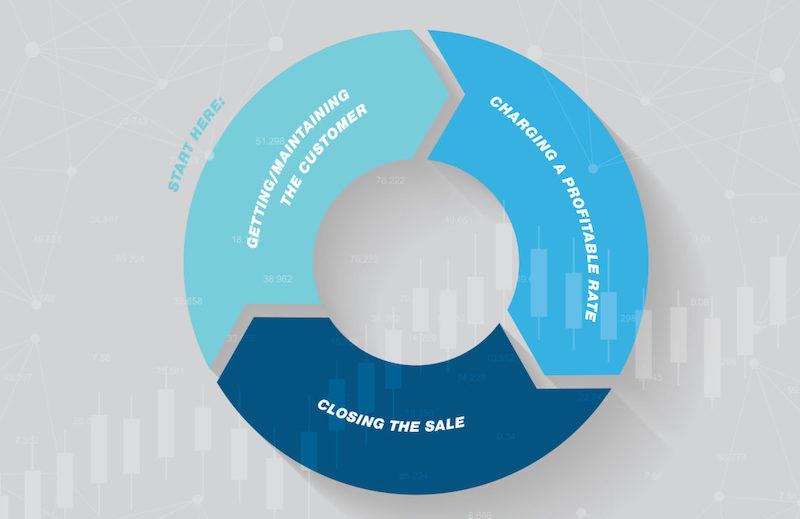
It’s never just that simple (Image source).
This, of course is the 30,000 foot view which aims to apply to all businesses.
But as we know, there are many sales and marketing steps that go into “Getting the customer” and “closing the sale,” especially for B2B companies.
For this article we’ll be diving into the marketing side of the cycle.
How long is a sales cycle?
So what period of time signifies a sales cycle as long as opposed to short? There’s no benchmark time period that can apply to all industries, but I would argue that any sale that typically takes several touch points (for example, paid search, display, email marketing, organic, white paper download etc.), and spans over several weeks to months is typically considered a longer sales cycle.
Think about B2B projects where where a business proposal is involved and stakeholders have to carefully analyze the price, ROI, and scope of the project. A better representation of a long sales cycle is below:
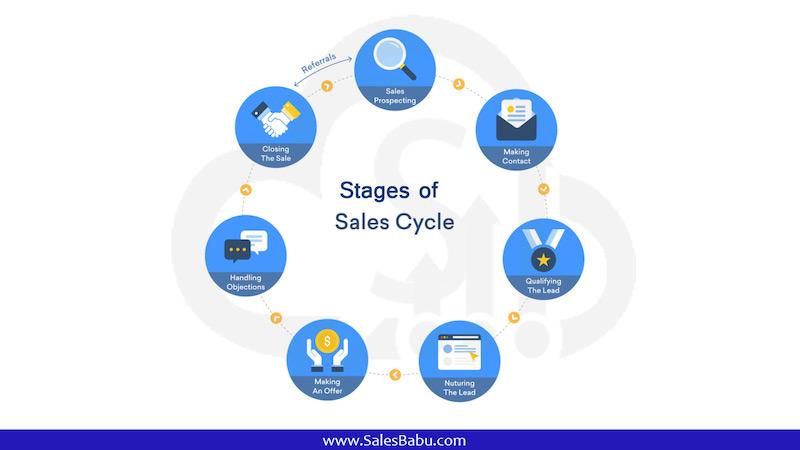
In contrast, most B2C offerings—such as with hygiene, retail, or buy online products—have a short sales cycle that often gets repeated significantly more frequently than B2B sales cycles.
In this post, we’ll be looking at the long sales cycle.
The sales cycle vs sales funnel
The sales funnel and sales cycle are essentially one and the same. But if you must distinguish them, you can think of it like this: The sales cycle is a representation of the process by which a prospect becomes a customer, while the funnel represents the strategies and offerings you use to move them through that process.
If you’re a marketer then you are likely familiar with the concept of the marketing funnel, a model that dates back to 1898 that maps out the customer journey starting at the wide opening at the top of the funnel and narrowing down to the bottom. The top of the funnel is largest because it captures all of your potential customers, but as time and engagement unfold, only a certain percentage of prospects within each stage will move on to the next stage of the funnel—hence why the bottom is so narrow.
The stages vary per business, but typically include something like awareness, consideration/interest, conversion, and potential further actions.
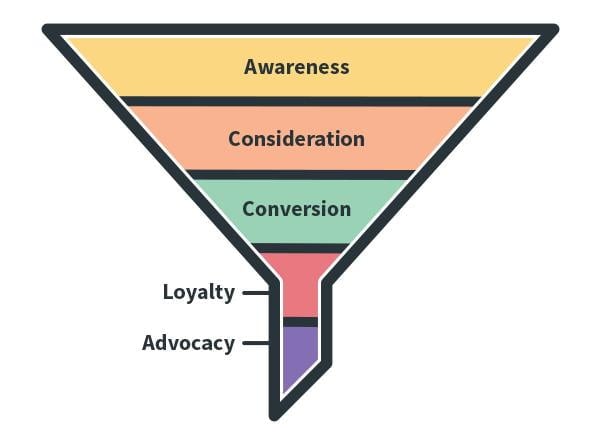
Several marketing scientists have come up with various theories suggesting the funnel should be revamped into a pyramid or circle. “Consumers are now more informed, connected, and empowered than ever. Does the funnel still work in a digital, social, mobile age?” pondered a study published in the Harvard Business Review.
Prospects don’t just enter at the top of the funnel; instead, they come in at any stage, jump stages, stay in a stage indefinitely, or move back and forth between them.
After talking to companies such as Google, Sephora, Twitter, and Visa, researchers found that: “the primary problem with the funnel is the buying process is no longer linear. Prospects don’t just enter at the top of the funnel; instead, they come in at any stage, jump stages, stay in a stage indefinitely, or move back and forth between them.” The study goes on to explain McKinsey’s Customer Decision Journey model, which is circular rather than linear.
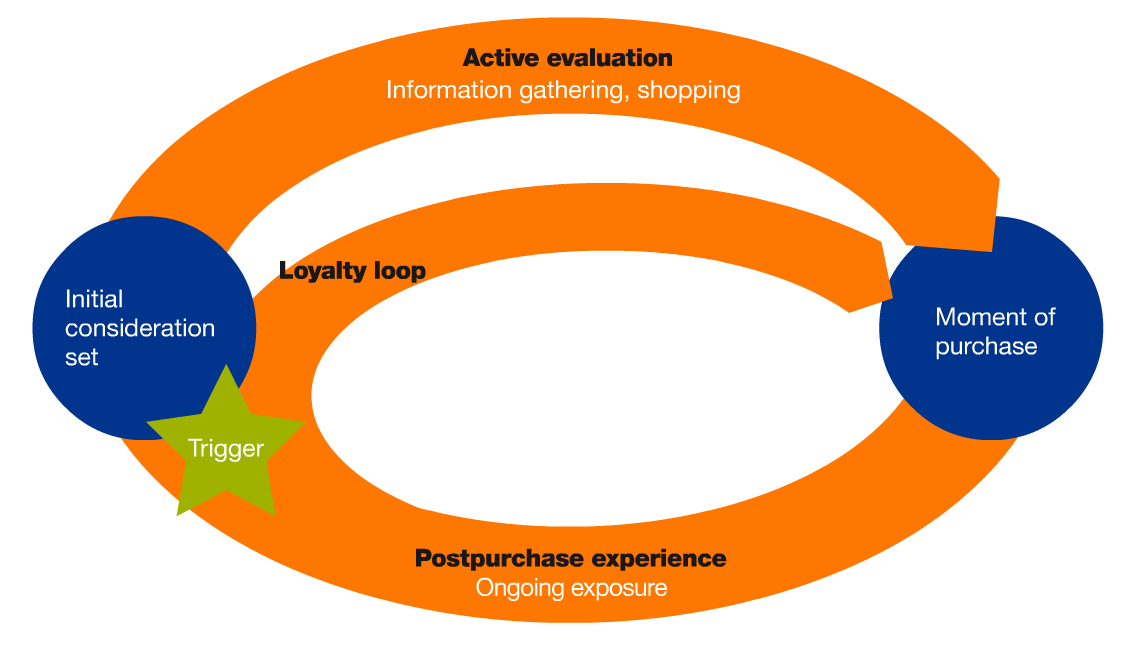
Whether your funnel is linear, circular, or fluorescently rainbow patterned, the bottom line is that a significant quantity of qualified leads need to be moving through your sales cycle to earn you money and grow your business. So what can be done to battle against a longer sales cycle and keep your leads engaged and moving? Read on, my friend.
6 marketing tactics to speed up your long sales cycle
After extensive research and in-depth conversations with experienced marketing professionals across B2B industries, I’ve discovered these six marketing tactics that will help not only cut down the length of your sales cycle, but also push a larger audience through the cycle to increase total sales.
1. Implement a “top of the funnel” paid search strategy
Take a moment to reflect on the last time you made an expensive purchase. One of the first things you likely did is conducted some research on Google to see what your options were, did some comparison shopping, and just got a general sense of what companies and offerings were in the space. I do this all the time even with smaller purchases, like a massage appointment or new piece of clothing, but with larger purchases that are more of a financial commitment, the chances of that being the first and last action you take are slim to none. This needs to be kept in mind when implementing your paid search strategy (which is absolutely necessary!).
If you’re doubting why you need to pay for ads on Google, then banish these thoughts from your mind and start using the more logical side of your brain. Longer sales cycles go hand in hand with extensive research, and guess where your leads likely start? Google!
If you’re not appearing in the SERPs then you are losing the huge audience that is conducting research to eventually make a purchase; if you are showing up in the top positions then you’re presented with the opportunity to gain site visitors that you can then nurture and eventually convert into loyal, paying customers.
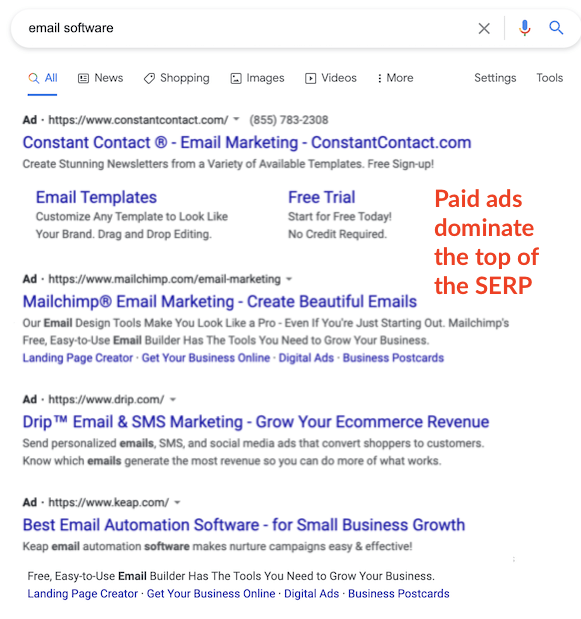
Showing up at the top of the SERP can get your leads on the path to the bottom of your funnel.
So how do you distinguish your offers as “top of the funnel?” Well, you need to conduct thorough keyword research and avoid terms like “buy now,” “apply now,” or “signup today” – you get the gist. If your calls to action are too aggressive, then the searchers are going to feel like you’re proposing on the first date. Take a step back and get into the mind-set of the searcher. Instead cater your paid search experience to…
Target keywords for people conducting research
For instance if you are selling marketing software, target “marketing automation help” or “marketing management solution.”
Present an ad that highlights why you’re better than your competitors.
You’re most likely going to be appearing right alongside them (hopefully in front) so your ad copy needs to highlight some compelling offers. Do you have free shipping or a money back guarantee policy that your top competitor doesn’t offer? Then create ad extensions, such as sitelinks and callout extensions, to highlight these benefits.
Check out the example below from Marketo. This ad is great because it highlights several benefits of their software and gives it validation with social proof from their followers on Google+. It’s also not overly aggressive with language that hints at making a purchase; rather the links all direct to educational offers, which brings me to my next point…

Create landing pages that cater to educational content
This includes a white paper download or e-book rather than presenting your product or offering off the bat. Remember, these people are top of the funnel. If they already knew about your service they probably wouldn’t be searching. Direct them to a page that provides educational content, continue to nurture them, and push them closer to commitment.
2. Align content and offerings with progressions within the long sales cycle
Have you ever received an offering prompting you to opt into a newsletter or sign up for a demo when you weren’t even familiar with the company’s brand? You look cross-eyed at the email and hit your trash icon while simultaneously rolling your eyes. Pushing too hard before the lead is ready will blow up in your face. But how do you ensure potential leads don’t slip through the cracks?
Provide ongoing thought leadership and education.
Do not serve up your offerings right away, but rather establish brand awareness and credibility with quality content. “We like to stay top of mind from a marketing perspective by providing ongoing thought leadership,” says Laura Taylor, WordStream’s Vice President of Acquisition and Experience Design. “Part of a robust marketing strategy is to make sure you have educational content all along the funnel.”
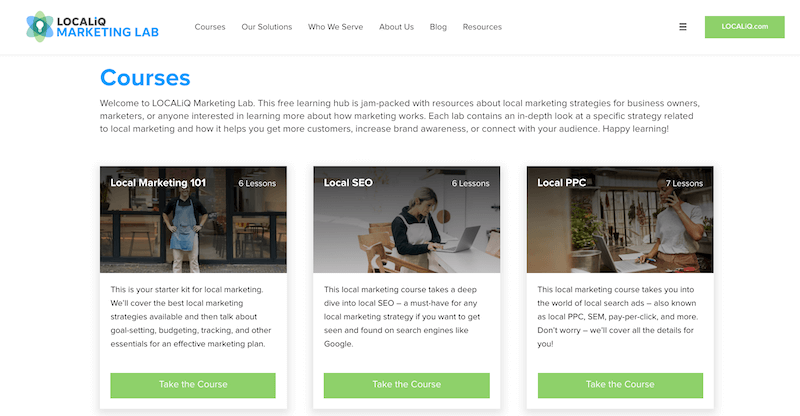
LOCALiQ’s Local Marketing Lab is a great example of educational content
Integrate your thought-leadership content with promotional offerings.
There needs to be a strategized balance between education content and offers that showcase your product. “If all you have is thought leadership, but nothing to evaluate your product, and then position it as a solution to solve a problem, then leads become stuck,” says Laura.
“Another pitfall would be offering all product promotional materials like buying guides and demos. There needs to be a balance and flow, where your content is being offered along the cycle and leads don’t consistently feel like you’re trying to back them into a corner.”
Look at the first action taken and prescribe from there.
WordStream’s Lead Nurturing Manager, Callahan McGuinness, explained to me how important the first action taken is because it shows where the lead is within the funnel. For example if they sign up for a trial then the assumption can be made that they’re a bit more knowledgeable because they took the action to sign up and actually explore the software. “That first action helps you know what to put in front of them and how often,” says Callahan.
Scale back on marketing emails once a lead becomes an SQL (sales qualified lead)
If a lead is getting closer and closer to converting and now assigned to a sales representative to guide them through the final stages, then marketing messages need to tone it down a notch. “Not only is an SQL getting marketing emails, but also emails from sales so once the lead turns into an SQL we scale back significantly so they can build that personal relationship with the rep,” says Callahan. The SQL is then also taken out of new content downloads and webinar invites which are for those in the earlier stages in the funnel.
3. Drive Action by Making the Experience Personalized & Relating with Each Prospect
I’d assume your inbox is often swamped with marketing emails that you have to scroll to the bottom to find that tiny “unsubscribe” option. Have you ever called a business in hopes of speaking to (gasp) a real-live, breathing human being, but instead are directed from one automated operator to another? We’re all constantly swamped with marketing messages the second we wake up and scroll through our social feeds. People are becoming pretty excellent at dismissing them, so how do you make your touch-points during the sales cycle more effective?
Well, how about personalizing the experience?

When a company is outrageously promotional, slapping their brand in front of your face, it’s an instant turn-off. In contrast, when the company connects on a more personalized level and gains an actual understanding of your interests, then your engagement level increases. But first you need to gain the trust from your leads so that they’re willing to reveal more information about themselves.
As Laura explains, “Within a system like Pandora or Spotify you can say ‘I’m interested in country or rock music’ and you can do a level of granularity, but when someone distinguishes that they like Taylor Swift’s ‘Blank Spaces’ song, but not Carrie Underwood’s ‘Something in the Water,’ at that point you’re able to nurture much more granularly.”
How can this be done? Start off with these strategies:
Put a face to your brand:
You need employees that act as brand promoters and represent the face of your company, whether that be your founder or a respected higher-up. “Having a person or group of people that are the voice of the brand helps people connect more with the company; it’s not just I’m working with WordStream, but rather I’m working with Larry or Elisa, making the experience much more personal,” says Laura.
EverTrue uses a similar strategy. I recently spoke with Jesse Weiss, Manager of Demand Generation, at the Boston-based SaaS startup, EverTrue, which offers donor software solutions to help higher education and non-profits expand their donor network and work towards their fundraising goals. He explained how their CEO & Founder, Brent Grinna, is constantly used to promote and add value to their brand. “He’s all over the place. He recently went to Brown and Harvard Business School to volunteer for fundraising,” Weiss explained. Even browsing around EverTrue’s site you can see that Brent is used to tell the “EverTrue story” and his picture as well as other members of the leadership team are highlighted on their “About Us” page.
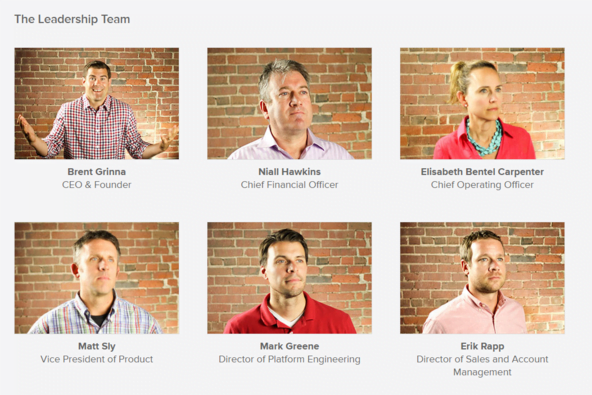
Personalize touchpoints
Every marketing message should relate to that lead and be personalized at some level. For example an email blast should direct each customer by name. It also helps to have emails sent from an actual person or the “face of your brand” rather than a company email alias, but Callahan advises using the strategy sparingly. “Emails sent from Larry (WordStream’s founder and CTO) prove to be much more powerful, but we try not to overuse this strategy because then it won’t be as effective when needed. For example the first touchpoint once a lead signs up for a trial is a good opportunity to leverage this strategy and get the lead excited about our software.”
Weiss spoke candidly with me about tactics used to engage targeted prospects during their longer sales cycle, which typically spans across six months. He is a huge advocate of personalizing touchpoints to engage leads, for instance, he often uses strategies such as tagging universities in posts via Twitter or Facebook. “People love seeing photos they’re tagged in,” stated Weiss. “I’m constantly collaborating internally to create content that caters exclusively to our target prospects.”
Another strategy Weiss and his team have implemented is publishing blog posts that cover a list of universities they’re targeting to convert. “We’ll force rank universities at certain stages in the funnel and promote the posts through email, LinkedIn sponsored posts, or even having the BDR (business development rep) use that as a way to engage with them.” See the content below that EverTrue promoted on their blog to engage with the listed Universities.
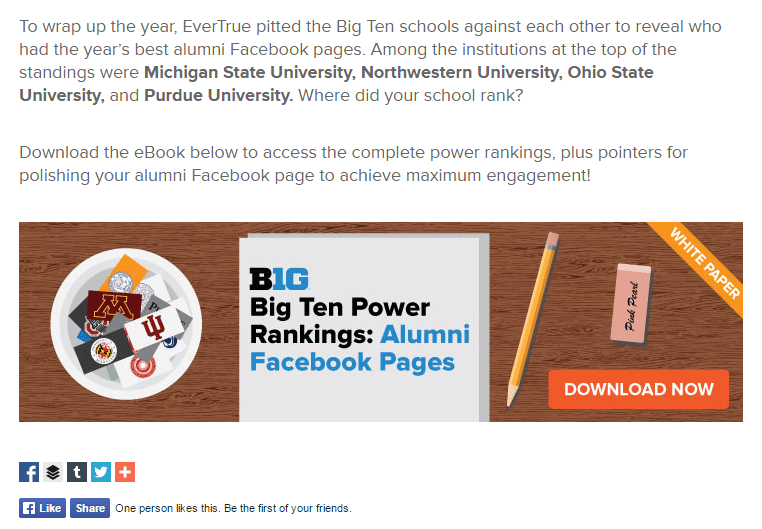
Use relatable language in all of your messaging: I was reading a blog post the other day and legitimately fell asleep with my MacBook on my lap. It was likely because the writing sucked. We know quality content is critical, but what makes content engaging during a sales cycle? At WordStream we’ve found that writing with personality and catering our messaging to relate to our audience is the way to go. “We always try to sound more conversational so we can seem more relatable as a brand,” says Callahan. “Having a message that’s thought-provoking and avoiding the urge to sound sales-y, but more solution based. We use softer sales tactics, subtle calls-to-action, and relate to them by saying things like ‘we feel your pain, we can help you.’”
EverTrue uses a similar strategy when it comes to their language usage. “We try to make our marketing messaging as candid as possible. We’ve always been very open when it comes to product innovation, and we try to spur conversations by tagging schools in our social posts,” says Weiss. “Our main goal is to stimulate a warm conversation between a lead and a BDR, and if we’ve done that then we’ve done our jobs.”
Create a strategic remarketing strategy: There are so many ways to remarket to those who have already visited you site, and the amount of granularity you can use to target a specific audience is incredible. Dig into your options and implement a strategy to cater to specific behaviors, for example you would want to remarket to an audience that that visited a trial or demo page in a different manner then those who simply read a blog post or visited your homepage.
4. Study Common Behaviors and Make Changes Accordingly
A/B test, A/B test, A/B test!!! This is something that all marketers are constantly preaching, but if you’re always testing then when will you actually arrive on an outcome? The lesson to learn is to test one element at a time, and not over test. If something is working then let it work! Don’t throw a road block in front of it because it could result in a fatal accident. Instead start by gaining insight into common behaviors.
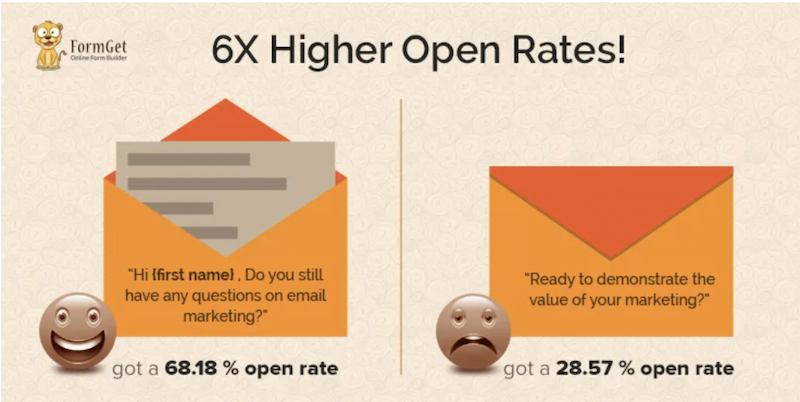
To constantly be improving the pace and effectiveness of the sales cycle you need to:
Prioritize data analysis
“Data should affect all of your decision making,” Callahan says. “We look at targets each month, break it out by channel and program, and ask what is and what isn’t working? How many SQL’s did we gain? Which pieces of content resonated?”
Data analysis can also be extremely time consuming and challenging, which is why Laura advises to not become paralyzed by the data, but rather make a hypothesis and test. “In our space it’s not as if visitors come to our website and make an ecommerce conversion. There are so many in-between’s that it’s difficult to know how conversions occur,” says Laura. “They might finally convert on a phone call, but every webinar, tweet, and blog that’s layered along the path might be tied to them.”
Make adjustments based on your analysis
Among our free offerings at WordStream are the WordStream Graders. These tools enable you to connect your Google Ads (AdWords) or Bing accounts to have our algorithms scrape through your account performance and give you a grade. After doing some data analysis our marketing team found that a chunk of people who start the grader abandon mid-process.
To combat this abandonment a survey was set up to pop up and email the lead who abandoned their Grader to find out why. It was found that security is a huge concern and the prime reason for abandonment. Therefore the Grader landing pages were adjusted in design to use language like “secure” with an image of a lock, and emails were sent out with impressive statistics showing how many advertisers and agencies have graded their accounts. This is just one example of how spending time to conduct studies and analyze data can make a huge impact on the effectiveness of your sales cycle.

5. Invest in a Marketing Automation Platform or Team to Nurture Leads
Utilizing marketing automation software to score leads and trigger communications is an absolute must if you want to scale and grow your leads as well as speed up your sales cycle. “Pay attention to activities your leads take. If they downloaded information about quality score, then we’ll target them for a quality score webinar,” says Laura, who is a huge proponent of marketing automation.
“Use marketing automation to set up triggers and program responses. Utilize lead scoring and treat it as a living, breathing model that you tweak over time and learn from because you’ll learn that maybe you’ve handed leads off too soon. Even if they’re showing signs of being qualified behaviorally, they might not be at that stage yet. It would be great if they could magically design triggers to signify a lead is ready to move from one stage to another, but they don’t always raise their hand. It requires data mining.”
This is why having a person or team dedicated to nurturing and analysis is critical. Laura describes how data integrity is a huge challenge: “Businesses start and close, people move from one business to another, people try things with one email address and then use another later on. Since nurturing is data based, it’s much more science then creativity. As much as every marketing software will claim to be able to visualize the flow of the database of leads, it’s still flawed in hygiene.” This is why you need people behind the automation to be able to take a huge mass of data, learn from it, and act on it.
At WordStream, Callahan owns nurturing, and is constantly working on the automated and point-in-time campaigns and using the database to help inform her on how to build the triggers.
As a startup employee, Weiss has found this to be a challenge at EverTrue. On a team of only three other marketers, his bandwidth is stretched very thin. While they do use the marketing software from HubSpot, his focus on customization and experimentation with the software has been limited, but is on his list of future endeavors. “Over the last few months we’ve created a huge volume of content, but now we need to figure out how to fit that into a more automated lead nurturing program,” he says. “If people get into our system they’ll receive a slew of emails, but they’re older, poorly branded, with little insight into how they’re progressing into any nurture queue.”
6. Maintain a Close and Transparent Relationship with Your Sales Team
Laura, Callahan, and Weiss all agreed that maintaining a positive, open, and transparent relationship with sales is absolutely critical to improve the flow of the sales cycle. Why? The answer is obvious: sales and marketing are like cheese and crackers, one is not complete without the other. To create a fluid, clear, and efficient sales cycle the lines of communication need to be wide open.
“Being aligned with sales is absolutely crucial in order for there to actually be sales,” Callahan says. “Communication, working together, listening to pain points, and not making rash decisions…It can be challenging because they have one goal and we have another, but it’s important to find the balance, and it’s rewarding when both teams can.”
So how can you ensure a positive and open relationship is maintained? Conduct regular meeting with sales managers, send emails seeking feedback, collaborate on content that goes to leads later in the sales process, fill sales in on content that’s being released, and be patient, open, and listen, learn, and adjust as needed.
What marketing strategies have you found to speed up a long sales cycle?







